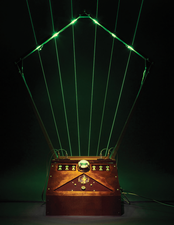Waveform 9 turns the Rasp Pi into a recording studio
Sound Machine

© Lead Image © Alexander Gorlov, 123RF.com
The Rasp Pi has enough performance to serve as a small digital audio workstation. Waveform 9 provides the necessary software.
Tracktion.com has been selling suites for music production – Digital Audio Workstations (DAWs) – for many years. Waveform 8 was the first Tracktion DAW that supported the ARM processor used with the Raspberry Pi. Since Spring 2018, the new Waveform 9 for the Rasp Pi (Figure 1) has proven that the experiment is a success.
Collecting Berries
To download and activate Waveform 9, visit the Marketplace section of Tracktion's website [1], for which you need an account. You'll need to purchase a license for $109 – around EUR93.50.
The virtual instruments and effects are only available for Linux on the x86 platform. However, the Rasp Pi variant contains all internal instruments and effects. You can install the Debian package for Waveform with dpkg -i on Ubuntu MATE for the Rasp Pi (see box entitled "Setup").
[...]
Buy this article as PDF
(incl. VAT)
Buy Linux Magazine
Subscribe to our Linux Newsletters
Find Linux and Open Source Jobs
Subscribe to our ADMIN Newsletters
Support Our Work
Linux Magazine content is made possible with support from readers like you. Please consider contributing when you’ve found an article to be beneficial.

News
-
Parrot OS Switches to KDE Plasma Desktop
Yet another distro is making the move to the KDE Plasma desktop.
-
TUXEDO Announces Gemini 17
TUXEDO Computers has released the fourth generation of its Gemini laptop with plenty of updates.
-
Two New Distros Adopt Enlightenment
MX Moksha and AV Linux 25 join ranks with Bodhi Linux and embrace the Enlightenment desktop.
-
Solus Linux 4.8 Removes Python 2
Solus Linux 4.8 has been released with the latest Linux kernel, updated desktops, and a key removal.
-
Zorin OS 18 Hits over a Million Downloads
If you doubt Linux isn't gaining popularity, you only have to look at Zorin OS's download numbers.
-
TUXEDO Computers Scraps Snapdragon X1E-Based Laptop
Due to issues with a Snapdragon CPU, TUXEDO Computers has cancelled its plans to release a laptop based on this elite hardware.
-
Debian Unleashes Debian Libre Live
Debian Libre Live keeps your machine free of proprietary software.
-
Valve Announces Pending Release of Steam Machine
Shout it to the heavens: Steam Machine, powered by Linux, is set to arrive in 2026.
-
Happy Birthday, ADMIN Magazine!
ADMIN is celebrating its 15th anniversary with issue #90.
-
Another Linux Malware Discovered
Russian hackers use Hyper-V to hide malware within Linux virtual machines.

